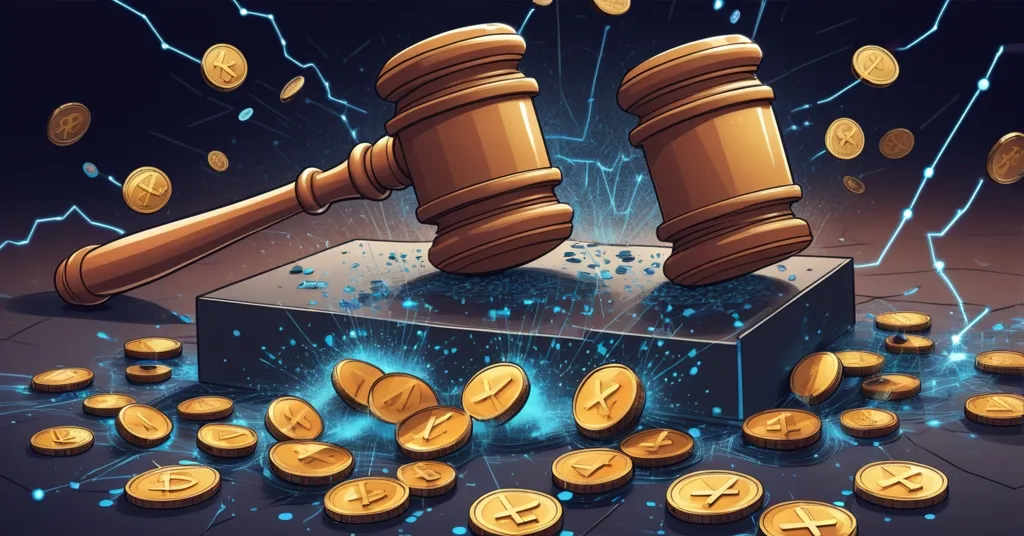SEC and Ripple Settle for $50M, Boosting XRP Price by 7.2%

Breaking: Ripple Settlement Agreement Filed by SEC
In a groundbreaking move, the SEC and Ripple have reached a settlement that could redefine cryptocurrency regulation, slashing Ripple’s penalty from $125 million to $50 million. This decision not only boosts XRP’s price by 7.2% but also signals a potential shift in how cryptocurrencies are regulated.
- Settlement slashes penalty from $125M to $50M
- Injunction lifted and XRP sales ruling upheld
- Appeal paused, case remanded for approval
The U.S. Securities and Exchange Commission (SEC) has settled with Ripple, marking a significant turn in the ongoing legal battle over XRP’s classification. The settlement agreement was laid out in a letter to Judge Analisa Torres of the Southern District of New York, requesting a preliminary decision to finalize the agreement. This move pauses the appeal at the Second Circuit, allowing the case to be remanded to the district court for formal approval. Once approved, both Ripple and the SEC can drop their appeals, bringing closure to this high-profile case.
An injunction, which is a court order that prevents certain actions, was initially imposed by Judge Torres. With the settlement, this injunction will be lifted, providing Ripple with more operational freedom. Additionally, the settlement upholds Judge Torres’s earlier summary judgment from July 2023, distinguishing between programmatic and institutional XRP sales. Programmatic sales, which are sales made through automated systems, were ruled not to be securities, while institutional sales were found to violate securities laws. This distinction is crucial as it could set a precedent for how other cryptocurrencies are treated by regulators.
The market’s reaction was swift, with XRP’s price jumping 7.2% in response to the news. This surge reflects investor optimism about the settlement’s impact on Ripple’s future and the potential for increased regulatory clarity in the crypto space. Imagine the relief at Ripple’s headquarters when they heard the penalty was cut in half! Ripple’s CEO might be celebrating with a bottle of XRP-aged champagne tonight.
For Ripple, the settlement is a victory, not just financially but also in how it positions the company moving forward. The reduced penalty and returned funds offer a lifeline, allowing Ripple to continue its mission of disrupting traditional financial systems. Meanwhile, the crypto community watches closely, as this case has broader implications for the regulatory treatment of digital assets.
While some might argue that the SEC’s decision to settle is a step back from enforcing strict regulations, it’s also a pragmatic move that acknowledges the complexities of regulating a rapidly evolving technology. Critics might point out that this could embolden other crypto companies to challenge regulatory decisions, but it also opens the door for more collaborative approaches between regulators and the industry.
In the spirit of effective accelerationism (e/acc), this settlement could accelerate the integration of blockchain technology into mainstream finance, fostering innovation while still addressing legitimate regulatory concerns. It’s a delicate balance, but one that could pave the way for a more decentralized and equitable financial future.
As we champion the cause of decentralization and the transformative power of blockchain technology, this settlement serves as a reminder of the challenges and victories that come with shaking up the financial status quo. It’s a testament to the resilience of projects like Ripple and the broader crypto ecosystem, which continue to push boundaries despite regulatory hurdles.
Yet, it’s important to remain grounded amid the celebration. The crypto space is rife with challenges, from regulatory uncertainty to market volatility. While this settlement is a win for Ripple, it’s a reminder that the road to widespread adoption and acceptance is fraught with obstacles. The crypto community must continue to advocate for policies that support innovation while ensuring investor protection.
While the settlement is a clear victory for Ripple, it’s not without its detractors. Some might argue that the SEC’s move to settle is a sign of weakness, potentially encouraging other companies to push the boundaries of regulation. However, it’s also a pragmatic acknowledgment of the challenges in regulating a technology that evolves at breakneck speed. The crypto community must now navigate this new landscape, balancing innovation with compliance.
As we look to the future, this settlement could set a precedent for how other cryptocurrencies are regulated, particularly in distinguishing between programmatic and institutional sales. It’s a step towards clarity, but the journey is far from over. The crypto space remains a wild frontier, where every victory is hard-won and every challenge is an opportunity to grow.
Key Takeaways and Questions
- What is the new penalty amount for Ripple after the settlement?
The new penalty amount for Ripple is $50 million, reduced from $125 million.
- What does the settlement mean for the injunction imposed by Judge Torres?
The settlement includes lifting the injunction that Judge Torres imposed as part of the final judgment.
- How has the settlement affected XRP’s price?
Following the settlement news, XRP’s price increased by 7.2% over the past 24 hours.
- What is the significance of the Second Circuit’s pause on the appeal?
The pause allowed the parties to finalize the settlement process, paving the way for the case to be remanded to the district court for approval.
- What aspect of Judge Torres’s summary judgment will not be modified?
The parties agreed not to seek modification of Judge Torres’s summary judgment order from July 2023, which stated that programmatic XRP sales were not securities, but institutional sales violated securities laws.
- What will happen once the settlement is formally approved by the district court?
Once formally approved, Ripple and the SEC will be able to voluntarily drop their appeals.



